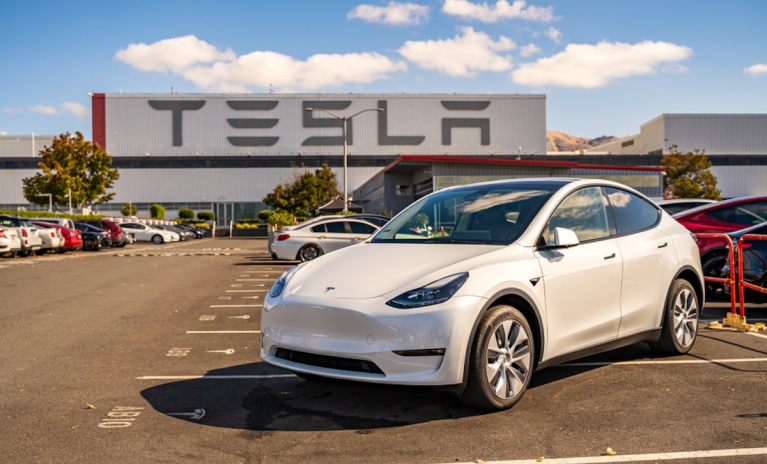
The global electric vehicle (EV) marketplace is seeing demand suffer under ongoing macro pressures.
That’s why, according to Tesla CEO Elon Musk, it’s a good thing that Tesla is not an EV company — it is a next-generation autonomy and artificial intelligence (AI) platform.
And per the company’s latest financial earnings call Tuesday (April 23), the company that Musk once told Bill Gates “does more good” for the world than “most charities” has identified the key role it will play in shaping the world’s future.
A role that looks a lot “like some combination of Airbnb and Uber,” says Musk.
This, as facing renewed investor scrutiny, supply chain and production hiccups, and a 55% drop in quarter-over-quarter profits, among other disruptions, Tesla wants to add another pillar to its sprawling ecosystem — a rideshare and robotaxi app, based on autonomous EVs that don’t exist yet. But are still penciled in for an August launch.
“We have been investing in the hardware and software ecosystems necessary to achieve vehicle autonomy and a ride-hailing service,” Tesla wrote in its latest release.
“We’ll be showcasing our purpose-built robotaxi, or Cybercab, in August … we’re really headed for an electric vehicle, an autonomous future,” Musk told investors on Tuesday.
And the promise worked — Tesla’s stock, which had been trading significantly down, jumped double digits on the news (as well as the news that production was accelerating on a new, lower-cost Tesla model). But will Tesla’s ridesharing robotaxi vision, a vision that has been shared by other high-flying startups, many of which have since crashed, work?
Read more: Musk Promises Tesla Robotaxis Amid Rocky EV Market
The investment thesis behind Tesla as a company is not EVs, rather it is a future-fit dream built atop AI and autonomy, one designed for a future where cars drive themselves and the hassles of parking, traffic and vehicle maintenance are things of the past.
Sounds nice, but while some observers view Tesla’s foray into ride-hailing via robotaxis as a visionary move that could unlock new revenue streams and boost Tesla’s market valuation, others are more cautious, citing the technological and regulatory challenges that lie ahead.
As for how — in theory, not in practice — the robotaxi service will work, Musk described it as a standard fare platform economy service and app.
“There will be some number of cars Tesla owns, and then there’ll be a bunch of cars where they’re owned by the end user. That end user can add or subtract their car to the fleet whenever they want, and they can decide if they want to only let the car be used by friends and family or only by 5-star users or by anyone at any time they could have the car come back to them and be exclusively theirs, like an Airbnb,” Musk said on Tuesday.
“I think no matter what, even if I got kidnapped by aliens tomorrow, Tesla will solve autonomy, maybe a little slower, but it would solve autonomy for vehicles at least,” Musk said.
But solving autonomy is one thing, and turning a profit is another. After all, 2023 was the first year since its 2013 founding that Uber turned a profit.
Read more: Earnings Season Shows Electric Vehicles’ Road to Ubiquity Has Curves and Bumps Ahead
As PYMNTS CEO Karen Webster wrote this past December, the problem facing that EV ecosystem today is there were not enough early adopters to create sufficient demand for suppliers of charging stations, so the U.S. lacks the density of fast charging stations that later adopters of EVs would require to give up gas. And investors in EVs may have underestimated the importance of that and overestimated the willingness of consumers to overlook battery anxiety based on the enthusiasm of those early adopters.
While the Tesla CEO has his work cut out for him in the robotaxi and ride-hailing space, he’s not alone. As Anna Brunelle, CFO at May Mobility, told PYMNTS in February, “I believe in our lifetime, not just automobiles, but every piece of moving machinery on the face of the earth will be automated. And the smart infrastructure that oversees it and supports it will also be automated.”
Musk’s future vision is one where millions of consumer-owned Teslas serve as AI-enabled computers that the company can tap into at will.
“Now that we have already paid for this compute in these cars, it might be wise to use them and not let them be idle … we want to use the computer as much as possible and close to like basically 100% of the time to make it a use of it. Because it takes a lot of intelligence to drive the car anyway. And when it’s not driving the car, you just put this intelligence to other uses,” Tesla Autopilot engineer Ashok Elluswamy said on Tuesday’s earnings call.
“If we’ve got millions and then tens of millions of vehicles out there where the computers are idle most of the time that we might well have them do something useful,” said Musk.
Step one for Tesla will be actually producing and selling those cars, it seems. And step two will have to be identifying the something useful.